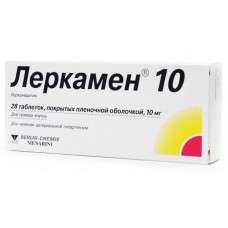Expiration date: 01/2026
Composition and form of release:
Film-coated tablets. 1 tablet contains active substance:
lercanidipine hydrochloride 10 mg
excipients: lactose monohydrate MCC carboxymethyl starch sodium (type A) povidone-K30 magnesium stearate
film shell: Opadray OY-SR-6497 (hypromellose, talc, titanium dioxide, macrogol 6000, iron oxide yellow dye)
in blisters, opaque PVC film/aluminum foil of 7 or 14 PCs. in a pack of cardboard 1 blister of 7 or 14 PCs. or 2 blisters of 14 PCs.
Description of the dosage form:
Round biconvex tablets, film-coated, from pale yellow to light yellow in color with a risk on one side. View on the break: light yellow.
Pharmacokinetics:
Lercanidipine is completely absorbed after oral administration. Cmax in blood plasma is detected after 1, 5-3 hours and is 3, 3 and 7, 66 ng / ml after taking 10 and 20 mg, respectively. Distribution from blood plasma to tissues and organs is rapid. The Association with plasma proteins exceeds 98%. Elimination occurs by biotransformation, about 50% of the dose is excreted in the urine.
The average value of T1 / 2 is 8-10 hours. The duration of the therapeutic effect is 24 hours. There is no accumulation during repeated reception.
Description of pharmacological action:
The blocker of "slow" calcium channels (bmcc), a derivative of the dihydropyridine series, inhibits the transmembrane current of calcium ions into vascular smooth muscle cells. The mechanism of hypotensive action is due to a direct relaxing effect on vascular smooth muscle cells, resulting in a reduced OPSS. It has a prolonged antihypertensive effect. Due to high selectivity to vascular smooth muscle cells, there is no negative inotropic effect.
Indications:
- essential arterial hypertension of mild and moderate severity.
Contraindications:
- hypersensitivity to lercanidipine, other dihydropyridine derivatives, or any component of the drug
- chronic heart failure (decompensation stage)
- unstable angina
- obstruction of blood vessels coming from the left ventricle of the heart
- within 1 month after a myocardial infarction
- severe liver function disorders
- impaired renal function (creatinine Cl <12 ml / min)
- lactose intolerance, galactosemia, glucose/galactose malabsorption syndrome
- pregnancy and breast-feeding
- women of childbearing age who do not use reliable contraception
- age up to 18 years (efficacy and safety have not been studied).
Caution: renal and/or hepatic insufficiency, older age syndrome of weakness of sinus node (without pacemaker) coronary artery disease left ventricular dysfunction.
Side effect:
The drug is well tolerated. Effects associated with vasodilating properties of the drug were rarely observed: peripheral edema, a feeling of blood flushing to the face, palpitations, tachycardia, chest pain, a marked decrease in blood PRESSURE, angina, asthenia, fatigue, headache, dizziness very rarely: gastrointestinal disorders (dyspepsia, nausea, vomiting, epigastric pain, diarrhea), a reversible increase in the activity of liver enzymes, myocardial infarction, polyuria, skin rash, drowsiness, myalgia, gum hyperplasia.
Drug interaction:
When conducting complex therapy, Lerkamen 10 is well compatible with beta-blockers, diuretics, ACE inhibitors.
Caution should be used with CYP3A4 inhibitors (ketoconazole, Itraconazole, erythromycin, etc.).
When prescribing the drug together with CYP3A4 inducers (antidepressants, rifampicin), it is possible to reduce the hypotensive effect of the drug.
When using Lerkamen 10 simultaneously with cardiac glycosides, it is necessary to monitor for signs of digoxin intoxication.
Simultaneous use with cimetidine does not cause significant changes in the concentration of lercanidipine in plasma, with high doses of cimetidine, the bioavailability and hypotensive effect of lercanidipine may increase.
It is possible to increase the hypotensive effect when using grapefruit juice.
The use of ethanol can potentiate the effect of the drug.
Dosage and administration:
Inside.
1 table (10 mg) per day at least 15 minutes before meals, preferably in the morning, without chewing, drinking enough water. Depending on the achieved therapeutic effect, the dose can be increased to 2 tables (20 mg). The therapeutic dose is selected gradually, increasing the dose to 20 mg is carried out 2 weeks after the start of taking the drug.
Use in elderly patients
No dose adjustment is required.
Use in patients with impaired renal or liver function
In the presence of renal or hepatic insufficiency of mild or moderate severity, as a rule, dose adjustment is not required, the initial dose is 10 mg, then you should carefully increase the dose to 20 mg.
Overdose:
There is no information about an overdose. It can be assumed that the symptoms are similar to those of other dihydropyridine derivatives (peripheral vasodilation with arterial hypotension and reflex tachycardia, increased frequency and duration of angina attacks, myocardial infarction). In case of overdose, symptomatic therapy is performed.
Precautionary measures:
Influence on the ability to drive a car or perform work that requires increased speed of physical and mental reactions
Since vertigo, asthenia, fatigue and, in rare cases, drowsiness may occur during Lerkamen 10 therapy, patients should drive with extreme caution and engage in other potentially dangerous activities that require a high rate of psychomotor reactions.



